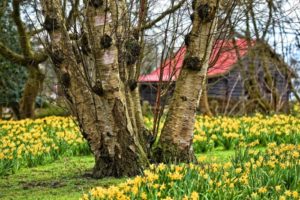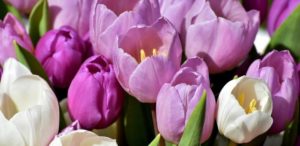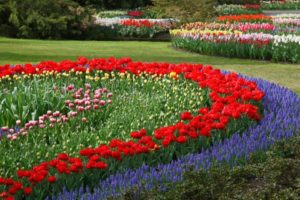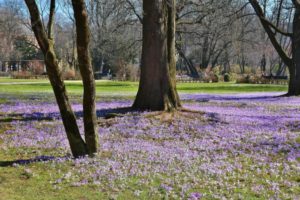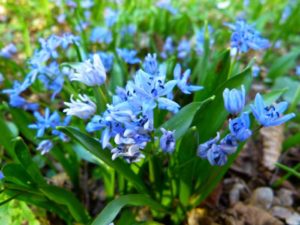Page 2
Color Effects
Looking at the large photograph of the woodland garden (top of page 1), you can see how effectively bands of color are displayed not only close-up but also from a distance. The effect would not be this dramatic if the colors were not clearly defined.
Also attractive is this simple sweep (photo, above) of naturalized yellow daffodils (Narcissus). From a distance, masses of the same color create a memorable display.
Related colors planted together work well, such as variations of yellow and cream, or warm colors such as red, orange, and yellow. Shades of blue and white, and vibrant red-yellow-blue combinations are popular.
If the flower colors were intermingled within a drift or in a bed, I chose closely-related colors, especially where the garden was viewed from a distance. However, in your garden it’s your choice. Bulb suppliers offer many mixtures blended in popular color combinations.
Mixing several colors or species together results in a more spotty effect. Color saturation and richness are lost. It’s difficult to focus on how the beauty of the display relates to the context of the landscape. We tend to glance from one flower to another, without seeing how the floral display fits into the big picture.
If you like some diversity, use colors that blend well with each other in adjacent bands, and use lots of the same variety within each drift. Or use shades of the same color (photo, above, pink and white tulips).
Record the cultivar names and take pictures of the ones you like, and add to the collection in subsequent years. Dividing and resetting spring-flowering bulbs is another way to economically enlarge your gardens, or you can trade varieties with your friends and garden club members.
Formal and Informal
Bulbs are at home in both formal and informal settings. Well-mannered tulips, daffodils, and hyacinths are beautiful in formal parterres and in mass plantings. A large potful of them is a welcome sight near the front door or on the patio.
They also fit into the natural landscape, spreading by bulblets (or bulbils) and some by seed. With proper selection, spring-flowering bulbs you planted can be enjoyed by generations of gardeners!
There was a property in Brookeville, Maryland, I used to see on my way to the Carroll County Farmers’ Market, where I sold plants in early spring. Every year, I slowly drove by that house on Georgia Avenue to admire the sight of thousands of short lilac flowers carpeting the ground under some old trees (as in photo, above).
This was an early snow crocus, and the patch expanded every year for decades. Because this crocus is an early riser, its foliage ripened naturally before the first mowing.
Naturalizing In Lawns
Bulbs that are suitable for naturalizing in lawns need to emerge, flower, and plump up again for next year before the first mowing. Plants exposed to sunlight produce food in their leaves through photosynthesis. This food is stored as carbohydrates in the bulbs, and ensures that the cycle of growth can be repeated the next year.
Removing functioning foliage weakens the bulbs, and does not allow enough time for the flower buds to develop. So, next year you’ll have fewer flowers. In the future, let the foliage turn yellow before removing it. The bulbs eventually will bloom again, after they’ve gathered enough strength.
Short, early spring-flowering bulbs suitable for naturalizing in lawns include:
- glory of the snow (Chionodoxa forbesii, C. lucilliae, C. sardensis)
- snowdrops (Galanthus)
- species or snow crocus (Crocus biflorus, chrysanthus, C. sieberi, C. tommasinianus)
- squill or scilla (Scilla bifolia rosea, S. tubergeniana, S. siberica.)
- winter aconite (Eranthis hyemalis), part sun
Naturalizing in Meadows
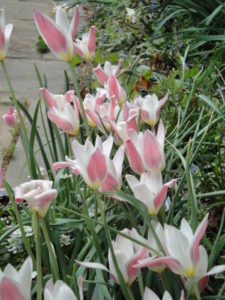
Tulipa clusiana ‘Lady Jane’.
In short meadows and in lawns that are permitted to go “rough” (delay mowing and fertilizing to allow bulb foliage to mature), plant varieties of:
- checkered lily (Fritillaria meleagris)
- early to mid-spring daffodils (Narcissus)
- grape hyacinths (Muscari armeniacum, M. aucheri, M. comosum, M. latifolium)
- snowdrops (Galanthus elwesii)
- species tulips (Tulipa acuminata, T. clusiana ‘Lady Jane’, ‘Tubergen’s Gem’, T. turkestanica). Look for varieties that are 10″ or taller and that have a more “wild” appearance so they fit better into a meadow. In Maryland, T. clusiana ‘Lady Jane’ returned year after year, popping up here and there after each revision of the landscape.
- spring starflower (Ipheion uniflorum)
- striped squill (Puschkinia scilloides var. libanotica)
Try other species to see if they can work in your gardens. If you mark their locations before they die down, you could dig up the bulbs and plant them elsewhere if the timing or the look isn’t right.
If You’re New To Spring-Flowering Bulbs
Spring-flowering bulbs provide a head start to the growing season, making winter seem as if it’s coming to an end. Use generous quantities of bulbs, preferably in clusters or drifts of the same variety, or a few varieties in colors that relate to each other. Keep in mind when they normally flower, so you can plan a succession of bloom. It’s helpful to keep notes and photographs from year to year, so you can fine-tune the timing, if you wish, by moving bulbs around or by adding new ones.
Cultivar selection, microclimates, and local weather conditions affect the exact time of bloom. Microclimates are localized warm spots in the garden created by protective south-facing walls or hedges, or cool spots caused by the shade of buildings or winter wind exposure.
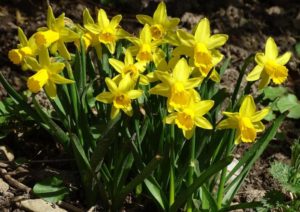
Daffodils.
If you’re new to the fascinating world of spring-flowering bulbs, and want to start slowly, purchase a dozen large daffodils, all of the same variety. Plant them by the mailbox, next to the sidewalk, or close to the front door, about 6″ apart from each other. I’ve included some suggestions detailed below, under “Narcissus“. Now, wait for the spring blooms… Gorgeous—and easy—right?
Next year, you might add to a backyard border a few dozen bright yellow crocuses (‘Yellow Mammoth’) that you can see from the kitchen window, planted in front of a drift of galanthus or early white and pale yellow daffodils.
When Planting Drifts of Bulbs
Microclimates and Timing
Microclimates and the weather will determine to a great degree when the bulbs will flower. Catalogs and labels are general guidelines. So don’t be disappointed if Scilla siberica doesn’t coincide at precisely the same time as Galanthus or species crocuses. They could bloom weeks apart one year, or concurrently the next.
Timing for the emergence of first-year bulbs can be a little “off”. Also, bulbs that are planted in late autumn usually flower later than the same variety planted in early autumn. Better late than never, but for the best quality bulbs, look for them in late summer to early autumn. And don’t delay planting them!
An exception is planting tulips in warm regions. Gardeners in Zone 7 or 8 and south need to refrigerate the bulbs for 10 or 12 weeks, to fulfill their cold requirement, before planting around the end of the year. You might find a garden center or an online supplier that sells “pre-cooled” tulip bulbs.
For gardeners in climates where spring warms up early, use early or mid season bloomers instead of late blooming varieties. A sudden blast of hot weather can fade the daffodils within a couple of days. There’s less chance of that happening with earlier varieties.
Laying Out the Beds
Design the bulb beds so that the drifts of spring-flowering bulbs will be arranged approximately perpendicular to the line of vision. This is a general guideline, but is more satisfactory because this arrangement “stops” the eye from wandering beyond the display, allowing the viewer to enjoy the garden a few moments longer.
The same principle applies to flagstones or bricks in a walkway. When the longer axes of the rectangular stones are perpendicular, instead of parallel, to the direction of the path, you tend to slow down (and enjoy more) your walk down the path.
Plant the earliest blooming varieties toward the back of the bed, if you’re going to plant more than one drift. After the earliest variety is finishing up its bloom, the fresh-looking next-to-flower variety will help hide the fading flowers and older foliage of the first-bloomers.
Bulbs’ flowers tend to face the sun (generally south, in the northern hemisphere). Bulbs, especially daffodils and tulips, will “show their faces” to viewers south of the bed.
For viewing from the north, bulbs planted on the north side of a wall or a group of evergreens will encourage the flowers to open facing the bright open sky instead of turning their faces to the south.
Aftercare
Cut off the faded flowers, but not the leaves, so energy can go toward making a bigger bulb for next year instead of into seed production. Most of the “major” bulbs, such as daffodils, tulips, and hyacinths, are treated this way. Where you want to encourage naturalizing of the botanical, species, or wild types, just let them do their thing; some will spread by seed and others by bulb division.
Don’t forget to fertilize when the leaves are actively photosynthesizing, right before or at peak bloom.
Headings
Page 1: Time For Spring Flowering Bulbs, On the Subject of Tulips, How Bulbs Work, and First, a few words on summer- and fall-blooming bulbs (Elephant Ears, Caladium, Amaryllis, Colchicum Autumnale, Fall Crocus)
Page 2: Color Effects, Formal and Informal, Naturalizing in Lawns, Naturalizing in Meadows, If You’re New To Spring-Flowering Bulbs, When Planting Drifts of Bulbs (Microclimates and Timing, Laying Out the Beds), and Aftercare
Page 3: Galanthus, Crocus (Snow Crocus, Giant Dutch Crocus), Eranthis, Muscari, and Puschkinia
Page 4: Hyacinthoides, Tulipa (Tulips In Zones 7 and South, Species Tulips), Hyacinthus, Narcissus (Buying Daffodil Bulbs, Linnaeus, the RHS, and the ADS, Planting Daffodils, Fragrant Daffodils), and Allium
Page 5: Maintenance, Tricks to Hide Maturing Foliage, Stinzenplanten, Forcing Spring-Flowering Bulbs, Rock Gardens, and Don’t Overlook the Little Ones
